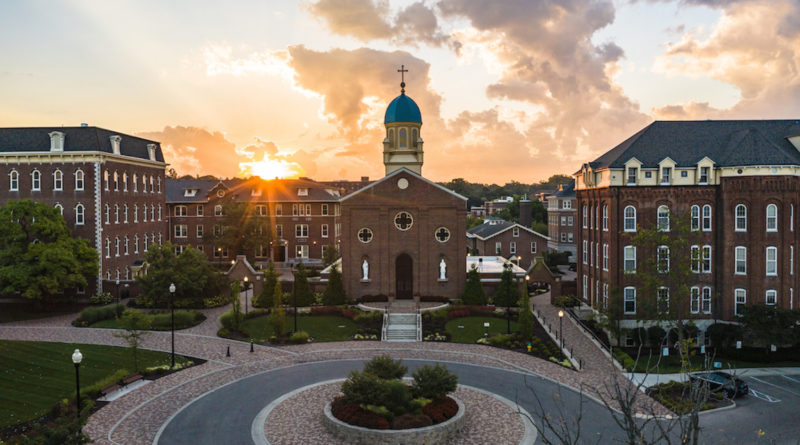First-year students create community despite limited interaction
UD first-years make an effort to create community amid COVID-19 pandemic, photo courtesy of Flyer News.
Carter Hahn
Contributing Writer
The University of Dayton freshman class of 2024 has had to find new ways to bond with each other as they were thrown into a new environment in August with rules limiting in-person interaction.
The new guidelines that UD implemented in response to COVID-19 this semester threatened to put the university’s principle of “community” at risk.
The Marianist commitment to community that UD strives to achieve means working hard to build the social framework of the community on campus. This year, the vision for a close-knit group of first-year students could end up being just that: a vision and not a reality.
UD had to implement numerous guidelines, like social distancing and mask requirements, that changed the atmosphere for the incoming first-year students.
Eden Michelson, a first-year student from Cincinnati, was surprised at what the mood on her floor at Marycrest was like once everybody was moved in.
“The atmosphere was definitely tense,” Michelson said.
“Everyone wanted to rush towards each other and be friends, but at the same time, we knew we couldn’t do that. No one wanted to get the virus, so we stayed pretty far from each other.”
Resident assistant Brandon Weiss said the spirit of his residents in Stuart Complex was remarkably similar to that of Michelson’s floor as people seemed to be on edge about the new coronavirus. Weiss also said his residents are not experiencing the same level of bonding as previous first-year students.
“I feel they’re not as close as they normally would be if the circumstances were better,” Weiss said.
“I don’t see specific groups getting to know a lot about each other, and I don’t see the strong connections that the first-year students made last year. They are friends, but their bond is not strong.”
Online classes hosted on Zoom have further hindered the process of bonding with other students.
Zoom was implemented in response to an increased threat of spreading the COVID-19 virus and was the only way that students could attend classes for the first month of the semester. Even now, Zoom continues to be used for some courses.
In hopes of encouraging communication, professors have tried to create breakout rooms where students can talk about the course material without the instructor being present. Their effectiveness as a platform for communication is questionable.
“As far as connecting with classmates, we’re definitely being cheated out of that,” Michelson said. “You can’t really build human connections over Zoom. Even in breakout rooms, we only talk about the course material.”
Zoom was also used during the first-year students’ orientation. Matthew Prock, a sophomore orientation leader for the incoming students, said that these meetings over Zoom proved to be an ineffective replacement for the students to get to know each other.
“On our Zoom calls, nobody interacted with each other at all,” Prock said. “It was as if they purposely kept their voices silent to just let me get through my presentation.”
Mason Haynes, also a sophomore orientation leader, encountered the same issue with his group.
“Zoom seemed to hinder their ability to speak to the other freshmen,” Haynes said. “They never really spoke with each other nor did they exchange personal information with the other members of our group.”
Although the first-year students have faced hardships and have had limited opportunities to meet new people, their efforts have not been entirely futile. Michelson said that she has made strong bonds with a few people on her floor. Still adhering to UD’s health guidelines, her method has been effective.
“My roommate and I would stand in our room near the window, and our floormates could stand in our doorway,” Michelson said. “We would still be six feet apart with our masks on. It was definitely weird, but it was cool to make an effort to get to know each other.”
Weiss’s residents had a different method of getting to know each other while still following the guidelines.
“After the (case) levels raised, they would eat their meals on Stuart hill together,” Weiss said. “Once the levels went down, they started to play intramural sports and play other games together on Stuart fields.”
For other students, an effective way to bond is through the socially distant events that UD holds every weekend. These events were designed to get students out of the residence halls they were confined to and into the fresh air. This also entailed meeting new friends and getting to know current friends even better. For Michelson, these events worked.
“I went to see Ferris Bueller’s Day Off the first weekend that I was here in August, and that helped me meet some new people,” Michelson said.
“For Halloween, I went to the Fall Festival at Old River Park with a couple of friends. Both events were really fun.”
Although the return to campus in the spring is uncertain, what is certain is that the first-year students will continue to find ways to create the ideal UD vision of community.
For more campus news like Flyer News on Facebook and follow us on Twitter (@FlyerNews & @FlyerNewsSports) and Instagram (@flyernews)

